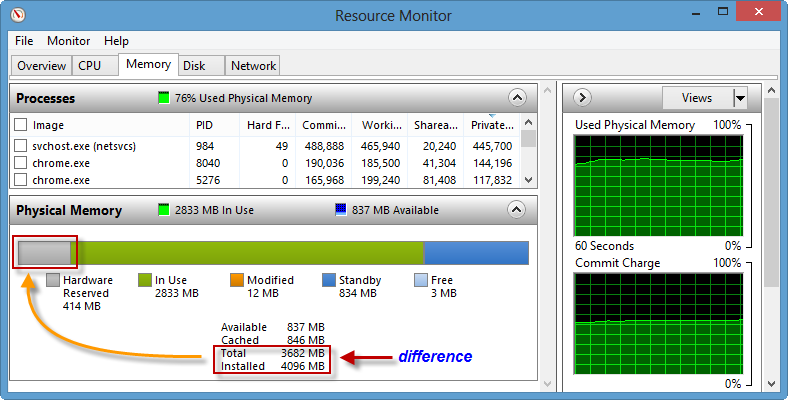Memory-mapped I/O vs port-mapped I/O
关于MMIO和PIO,我看到的解释最清楚的文章,原文在这里:Memory-mapped I/O vs port-mapped I/O - 2015
Microprocessors normally use two methods to connect external devices: memory mapped or port mapped I/O. However, as far as the peripheral is concerned, both methods are really identical.
Memory mapped I/O is mapped into the same address space as program memory and/or user memory, and is accessed in the same way.
Port mapped I/O uses a separate, dedicated address space and is accessed via a dedicated set of microprocessor instructions.
The difference between the two schemes occurs within the microprocessor. Intel has, for the most part, used the port mapped scheme for their microprocessors and Motorola has used the memory mapped scheme.
As 16-bit processors have become obsolete and replaced with 32-bit and 64-bit in general use, reserving ranges of memory address space for I/O is less of a problem, as the memory address space of the processor is usually much larger than the required space for all memory and I/O devices in a system.
Therefore, it has become more frequently practical to take advantage of the benefits of memory-mapped I/O. However, even with address space being no longer a major concern, neither I/O mapping method is universally superior to the other, and there will be cases where using port-mapped I/O is still preferable.

I/O
devices are mapped into the system memory map along with RAM and ROM.
To access a hardware device, simply read or write to those 'special'
addresses using the normal memory access instructions.
The advantage to this method is that every instruction which can access memory can be used to manipulate an I/O device.
The
disadvantage to this method is that the entire address bus must be
fully decoded for every device. For example, a machine with a 32-bit
address bus would require logic gates to resolve the state of all 32
address lines to properly decode the specific address of any device.
This increases the cost of adding hardware to the machine.

Picture source : IO Devices
I/O
devices are mapped into a separate address space. This is usually
accomplished by having a different set of signal lines to indicate a
memory access versus a port access. The address lines are usually shared
between the two address spaces, but less of them are used for accessing
ports. An example of this is the standard PC which uses 16 bits of port
address space, but 32 bits of memory address space.
The
advantage to this system is that less logic is needed to decode a
discrete address and therefore less cost to add hardware devices to a
machine. On the older PC compatible machines, only 10 bits of address
space were decoded for I/O ports and so there were only 1024 unique port
locations; modern PC's decode all 16 address lines. To read or write
from a hardware device, special port I/O instructions are used.
From a software perspective, this is a slight disadvantage because more
instructions are required to accomplish the same task. For instance, if
we wanted to test one bit on a memory mapped port, there is a single
instruction to test a bit in memory, but for ports we must read the data
into a register, then test the bit.
Comparison - Memory-mapped vs port-mapped
| Memory-mapped IO | Port-mapped IO |
|---|---|
| Same address bus to address memory and I/O devices | Different address spaces for memory and I/O devices |
| Access to the I/O devices using regular instructions | Uses a special class of CPU instructions to access I/O devices |
| Most widely used I/O method | x86 Intel microprocessors - IN and OUT instructions |
We can check the reserved memory address space from the Resource Monitor via our desktop's Task Manager.

Memory-mapped I/O vs port-mapped I/O的更多相关文章
- System and method for parallel execution of memory transactions using multiple memory models, including SSO, TSO, PSO and RMO
A data processor supports the use of multiple memory models by computer programs. At a device extern ...
- 【DM642学习笔记六】TI参考文档--DM642 Video Port Mini Driver
这个文档介绍了在DM642EVM板上视频采集和显示微驱动的使用和设计.用EDMA进行存储器和视频端口的数据传输.为了增强代码的复用性和简化设计过程,驱动分为通用视频端口层和特定编解码芯片微驱动层两个 ...
- Anatomy of a Program in Memory
Memory management is the heart of operating systems; it is crucial for both programming and system a ...
- [转]Anatomy of a Program in Memory
Memory management is the heart of operating systems; it is crucial for both programming and system a ...
- Method and apparatus for providing total and partial store ordering for a memory in multi-processor system
An improved memory model and implementation is disclosed. The memory model includes a Total Store Or ...
- Unity3D Optimizing Graphics Performance for iOS
原地址:http://blog.sina.com.cn/s/blog_72b936d801013ptr.html icense Comparisons http://unity3d.com/unity ...
- linux 查看系统状态方法
Linux下如何查看系统启动时间和运行时间 1.uptime命令输出:16:11:40 up 59 days, 4:21, 2 users, load average: 0.00, 0.01, 0.0 ...
- linux包之dmidecode
http://www.dmtf.org/standards/smbios Dmidecode 这款软件允许你在 Linux 系统下获取有关硬件方面的信息.Dmidecode 遵循 SMBIOS/DMI ...
- System Address Map Initialization in x86/x64 Architecture Part 2: PCI Express-Based Systems
原文 http://resources.infosecinstitute.com/system-address-map-initialization-x86x64-architecture-pa ...
- psutil官方文档
psutil documentation¶ Quick links Home page Install Blog Forum Download Development guide What’s new ...
随机推荐
- JavaScript阻止冒泡和取消事件默认行为
//功能:停止事件冒泡 function stopBubble(e) { if ( e && e.stopPropagation ) { e.stopPropagation(); } ...
- DB2 Catalog浅析&学习笔记
原文地址:http://king123654789.iteye.com/blog/1296492 Catalog 是远程连接部署在服务器端的DB2数据库的命令 [本文涉及到的命令] >db2 c ...
- fullpage在vue单页面当中使用会出现的问题以及解决办法
在 vue 单页面当中发现fullpage会报错,报错信息大概意思为,fullpage不允许初始化多次. 解决办法,在使用fullpage的组件跳转路由进入销毁组件之前的生命周期的时候对fullpag ...
- scroll与按钮的位置
<!doctype html> <html lang="en"> <head> <meta charset="UTF-8&quo ...
- Django ConnectionAbortedError WinError 10053 错误
因为ajax默认是异步提交,可是有时候我们会发现,本来要求请求马上出现,可是异步会导致后面突然再执行,这样就出问题了. (1)添加这样一段代码 $.ajaxSetup({ async : false ...
- PHP 几个常用的正则表达式
记录几个PHP中比较常用的正则. , $max_len = 20){ if (empty($username)) { return false; } $match = '/^(?![0-9]+$)[\ ...
- Scrollview总结:滑动问题、监听Scrollview实现头部局改变
ScrollView就是一个可以滚动的View,这个滚动的方向是垂直方向的,而HorizontalScrollView则是一个水平方向的可以滚动的View. ScrollView的简单介绍 Scrol ...
- 深入理解js中的立即执行函数(function(){…})()
javascript和其他编程语言相比比较随意,所以javascript代码中充满各种奇葩的写法,有时雾里看花,当然,能理解各型各色的写法也是对javascript语言特性更进一步的深入理解. ( f ...
- 通过XOML或者XAML的方式创建和启动工作流
在Workflow Foundation中,提供了多种设计工作流的方式.例如 纯代码的方式(C#) 代码分离的方式(XOML+C#) 以上两种,可以从Visual Studio提供的项目模板中选择 他 ...
- JavaScript 中那些关于坐标和距离的属性与方法
一 前言 在前端开发中总会遇到各种各样需要使用或计算坐标和距离的情况,但是这些属性和方法众多,全部熟练地记下来并非是一件易事,大多只能现查,耗费不少时间精力,于是便有了整理记录的想法,即加深了印象,又 ...
